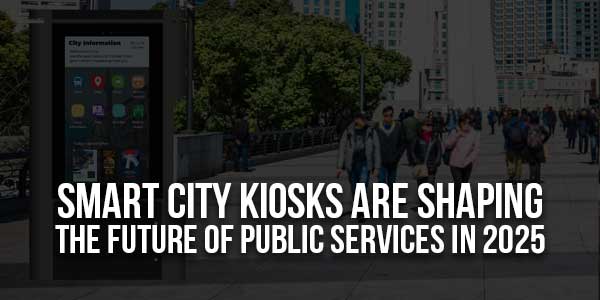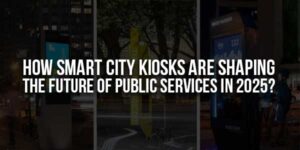
The smart city notion has become widely popular in the last few years, driven by technological innovation allowing for the infusion of intelligent systems into numerous aspects of urban living. Amongst these technologies are smart kiosks, with cities worldwide using them to drive civic betterment and economic development. The new interactive digital self-service platforms are changing the way public services are being delivered towards making cities more sustainable, accessible and efficient.
Smart city kiosks will reinvent city life from real-time information delivery to citizen engagement and simpler administrative processes by 2025. This article looks at how very efficient smart city kiosks are transforming public services, key features, user benefits, and current market trends driving their adoption. This article will also describe the operations through which smart cities could deploy smart kiosks and maximize the benefit of these kiosks towards building improved quality of life for citizens. This article will also talk about how smart cities can use smart kiosks and leverage their advantages to improve citizens’ quality of life. This article will also discuss how smart cities can incorporate smart kiosks and use their benefits to enhance the quality of life of citizens.
Table of Contents
The Evolution Of Smart City Kiosks:
Smart city kiosks have developed much from when they were first conceptualized. They were initially thought of as electronic billboards or information touchpoints. They have now turned into multifaceted devices with various purposes to fulfil. In 2025, the future for these kiosks will see more than just the mere dissemination of information, with the incorporation of cutting-edge technologies like Artificial Intelligence (AI), the Internet of Things (IoT), and real-time data analytics.
The classic role of smart city kiosks was to deliver tourists maps, directions, and minimal information on local points of interest. With the evolution of digital technologies, though, the kiosks have become interactive portals that do so much more. They have become gateways to a whole range of services such as government services, health data, transport news, payment transactions, and even emergency messages.
Urban areas will become more inclined to use these kiosks to simplify public service delivery in the next few years. For example, according to reports, over 500 kiosks were distributed across 19 metropolitan cities in the United States as of summer 2024. With the integration of data from several city departments, smart kiosks will provide information and services in real time to citizens and allow them to accomplish tasks at a quicker rate. This movement towards multi-purpose kiosks marks a bigger trend under the smart city initiative, which emphasizes connectivity, utilization of data, and citizen participation.
Enhancing Citizen Access To Public Services:
One of the greatest means through which smart city kiosks are revolutionizing public services is enhancing accessibility. Most city dwellers lack easy access to vital services due to geographical or socio-economic constraints. Smart city kiosks are intended to fill such gaps by offering an easily accessible platform that anybody can use to access a range of public services.
For instance, in most municipalities, citizens may pay utility bills, get local government forms, renew licenses, and register for community events all without ever needing to go into a government office. This is particularly significant for the disabled or the residents of poor communities. If properly integrated with assistive technologies like voice control or visual cues, kiosks can offer an inclusive service to more people.
The other great benefit is the ease of access to public services 24/7. In conventional systems, government offices are open only during working hours, restricting the delivery of basic services. Smart city kiosks are, however, available 24/7, and citizens can enjoy public services at their leisure. This adoption of 24/7 convenience is especially needed in high-speed, high-density urban cities where citizens will never have time to go to government offices to access services when they are open.
A Smarter Way To Interact With Local Government:
The provision of advertisements via outdoor kiosks is gradually evolving into a significant area of revenue for smart cities. In a prime example of civic involvement, the governments of smart cities might allow local businesses to advertise through these kiosks to garner extra revenue toward financing civic initiatives. The usage has reportedly been such that users spend anywhere from one to four minutes using these kiosks, giving a great opportunity for targeted advertising. With location-based services, ads can be made available to users based on geographical area, and businesses can target ads depending on the local needs of the area. Interactive adverts also enhance the user experience since they give multimedia components such as games, videos, and quizzes that catch the user’s attention and build interest in products and services locally available.
Sponsorships are also a good advertising platform, with companies receiving exposure through their logo being used on the kiosks, generating goodwill and name recognition in the community. Kiosks also enable local and regional ticket sales, allowing users to easily buy tickets for events without having to wait in lines. Those transactions help support local businesses and increase the economy of the city. Additionally, hyperlocal advertisements are a great means for local businesses to attract potential customers. Touchscreen kiosks have interactive capabilities and allow businesses to create entertaining digital experiences that encourage users to visit local establishments and bolster a healthy local economy. Hence, street kiosks are an effective means of advertisement for local business firms and even the general public.
At the same time, intelligent city kiosks will make reporting malfunctions like working streetlights, traffic jams, or security disturbances easy and seamless. By connecting with municipal databases, the kiosks can send reports to the concerned authorities immediately, initiating quicker response times. This feedback loop in real-time will enable governments to become more responsive and accountable to the people, building trust and participation.
Addressing Urban Challenges With Data-Driven Insights:
Smart city kiosks not only benefit the citizens but also city planners and administrators. In addition to aggregating data based on interactions, kiosks offer useful intelligence that can contribute to more informed decisions by the city in matters of infrastructure building, resource utilization, and policymaking. By combining IoT with data analytics, smart kiosks are enabled to harvest and process large sets of data in real-time. For instance, information about pedestrian traffic, usage patterns, and service needs can be used to align public transport routes with optimal efficiency, enhance waste management networks, and even plan public spaces that are more responsive to citizens’ requirements.
Apart from this, kiosks may serve as a communication centre during emergencies. Kiosks can provide life updates, evacuation instructions, and shelter availability in times of natural calamities. They could also encourage volunteers to join and help in building a better, more responsive, resilient city. As cities gather and interpret more data, the function of smart city kiosks will only grow. By using this information to tackle city problems, cities can become more efficient, more sustainable, and more responsive to the needs of their citizens.

The Smart City Kiosk Market And Future Trends:
The market for smart city kiosks is expanding at a fast pace with the growing demand for technology-based public services. With cities across the globe investing in digital infrastructure, the market for smart city kiosks is likely to see huge growth in the years to come. As per a recent market study by Pristine Market Insights, the worldwide smart city kiosk market is anticipated to reach large numbers by 2025 as more cities acknowledge the worth of these cutting-edge tools.
Various reasons are driving this growth. There is a current trend towards urbanization and the implementation of smart city technology. Municipalities are upgrading their public services as cities increase in population. Smart kiosks are an affordable and easily usable technique to meet those needs.
Smart city kiosks are also being propelled into advancement due to the proliferation of IoT and artificial intelligence technologies. Such technologies enable kiosks to offer services that are more context-aware and personalized and thus that are useful to governments and citizens alike. By 2025, we foresee kiosks equipped with the ability to predict citizens’ needs, modify their states to various environments, and be integrated with other smart city systems, including traffic management and environmental monitoring.
Further, progress in security technology will be fundamental to achieving universal adoption of smart city kiosks. Since kiosks will become centres for accessing confidential services, it will be all-important to preserve data security and privacy. Breakthroughs such as biometric authentication, encryption, and secure payment gateways will be crucial to instilling confidence in such systems and propelling mass use.
Conclusion: A Transformative Solution For The Future Of Cities:
According to the World Bank, 56% of the global population, i.e., 4.4 billion people, reside in urban places now. This situation is expected to prevail as the population residing in cities will grow more than double by 2050 when nearly 70% of the global population will be dwelling in urban places. As urbanization keeps on growing, the demand for smarter, more efficient cities has never been more. Progress in smart city technology is required to serve the needs of a more populous world.
Residents and visitors are now demanding more from their cities, looking for richer, personalized experiences that integrate innovation with daily convenience. That demand goes beyond mere connectivity, reaching into immersion such as augmented reality for navigation and the general use of artificial intelligence (AI) tools to provide personalized services. Just as AI is revolutionizing the restaurant space, these technologies can transform how cities operate and engage with their residents.
In this regard, smart city kiosks are becoming a pillar of future cityscapes. These kiosks, endowed with cutting-edge technologies, are a giant step towards making cities more connected, efficient, and people-centred public services. By delivering simple access to real-time information, city services, and interactive aspects, they make the overall experience for citizens and visitors better. Also, such intelligent kiosks are even looking to transform with next-generation technologies to further entrench themselves as essential elements of the cityscape. Looking ahead to 2025 and beyond, smart city kiosks will be playing a key role in developing cities not just as smart but also responsive and adaptive to the various needs of their citizens, opening the way for greener and wiser city living.

 About the Author:
About the Author:
















Be the first to write a comment.